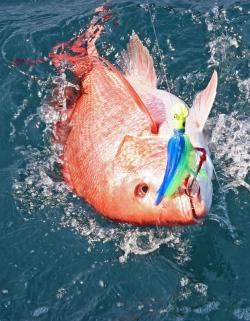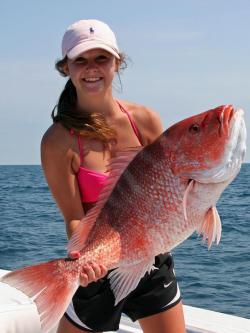Red Snapper Season–Short but Sweet
America’s favorite snapper is again legal as of June 1-but the season will be a scant 9 days long.
By Frank Sargeant
If there’s a shortage of red snapper in the Gulf, you can’t prove it by talking to anglers from Florida to Texas-these Alabama anglers loaded up. (Photo Credit David Rainer, ADCNR)Don’t blink or you’ll miss the red snapper season in federal waters of the Gulf of Mexico this year. It opens June 1, slams shut again just nine days later on June 10 thanks to a Byzantine federal management system that tightens the regulations ever more as the fishery gets better and better. (If we get a tropical storm on or about June 1, say goodbye to the entire season.)
Federal regulators say the rules are for the good of the fish-and ultimately of the fishermen.
But in fact, most experienced reef anglers say red snapper fishing is now better than it has been in at least 40 years thanks to an extended period of tight harvest regulations, and also perhaps due to the success of fish excluder devices on shrimp nets, allowing millions of juvenile snapper to escape these days when in the past they would have wound up as by-catch, dead on the deck.
The snapper are both much larger than they have been in decades, and much more numerous, according to hundreds of reports from fishermen all around the northern Gulf. It’s universal: anglers in Florida, Alabama, Mississippi, Louisiana and Texas all report booming snapper populations.
So why don’t the feds want to pony up longer seasons and more generous bag limits? Because of a bizarre twist in the way they calculate the harvest-they measure it in pounds, and when their best estimate of a conservation-smart harvest is achieved, they call for closure. Snapper grow fast and live a long time, and consequently anglers are now catching tons of whoppers-which means that they can catch a lot fewer before they reach those limits set by the feds.
To be sure, these restrictions are not arbitrarily contrived by the fish managers–they are mandated by the Magnuson-Stevens act, and more recently by a court decision–but the triggers on both these directives are based on badly-designed harvest surveys, which are the direct responsibility of the federal scientists.
Snapper take a variety of cut baits, live baits and sometimes heavy jigs, typically at depths of 60 feet and greater. (Photo Credit David Rainer, ADCNR)It is much like the paradoxical Catch 22, and it’s causing a furious reaction among fishermen and state fishery managers from Florida to Texas–most Gulf states are now moving rapidly toward putting their own harvest surveys in place for the species, tapping the capabilities of smart phones so that anglers can record their catches conveniently the minute they hit the docks.
In an unprecedented rebellion against the federal management system, all five Gulf states have all but quit cooperating with the NOAA system on this species. These days, state management is really starting to make sense, while it didn’t 30 years back. In the bad old days, only commercial fishermen had lobbyists and power to control the rules, and many fisheries suffered as a result.
But these days, the checks and balances of local recreational anglers and conservationists weigh in for keeping the maximum number of quality-sized fish in the water-and even the saltiest old commercial harvesters have finally come to realize that it just simply makes sense to guard the resource, so that they can not only make money fishing today, but also tomorrow, next month and next year. It should be noted that thanks goes to not only state agencies but also federal biologists for much of the research on offshore species that has made this awakening happen.
Florida has set a much longer red snapper season in state waters, up to 9 nautical miles offshore, extending from May 25 to July 14 this year, and other Gulf states are extending their seasons similarly and also working toward expanding the limit of state waters. How this all plays out remains to be seen–hopefully, better fishery stock analysis will put an end to the foolishness and restore some measure of cooperation between state and federal management agencies. In the meantime, whether you fish state or federal waters, here are some tactics that consistently produce results on red snapper.
HOW TO GET EM
Anglers who regularly target red snapper say they are not exactly “bottom fish”, even though they are nearly always found around hard structure. They’re usually found over structure, but not as often down in the structure like grouper.
Experts seek out what they call a snapper “Christmas tree” show on their sonar screens before dropping a line. The pyramid or “tree” is the shape made by a school of snapper, with most deep, fewer at the top. In 200 feet of water the stack may extend as much as 50 feet off bottom.
Many of the red snapper being caught these days are whoppers, the result of tight regulations including short seasons-but many anglers say there are enough fish now to loosen the reins a bit. (Photo Credit David Rainer, ADCNR)Gulf red snapper are typically found in 60 foot depths and more, on out to the edge of the continental shelf at around 250 to 280 feet-beyond this zone, the bottom drops away to a mile deep and more, and common reef fish are not found in those depths.
The Panhandle has a unique fishery in that there are hundreds and perhaps thousands of “private” reefs, that is junk that skippers have dropped on otherwise barren sand bottom to attract snapper-old washing machines, steel drums, all sorts of bulky trash. It’s not legal any more, but there are still many of these reefs around, and smart skippers have dozens of them in their GPS machines-all very carefully protected from other skippers who might want to pirate “their” fish.
There are also numerous legally-placed artificial reefs, including tugboats, barges and ships as well as demolition rubble, which attract lots of fish; these can be found on any good offshore chart. Most states also list them on their marine fisheries websites.
In general, the procedure is for the skipper to head for his favorite GPS number, drop anchor uptide when he gets there, and then let the anglers lower an assortment of frozen threadfins, cigar minnows or squid down on 60-pound-tackle. Using braided line makes it easier to feel the bite and get a good hookset, but you’ll need at least five feet of 60 to 80-pound-test mono leader to fool the fish and keep their teeth clear of the braid. (In extremely clear water or where the fish are being fished hard, it’s sometimes necessary to go to lighter tackle to fool snapper–you lose many but you get bit more often.)
Weights of 4 ounces and more are needed to get the bait deep, and hook sizes are typically 6/0 and larger circle hooks, extra-strong. (Circle hooks are required by law, as are hook removers, both aimed at improving survival of released reef fish. Venting devices, required formerly, are no longer on the must have list.)
The angler drops the bait to bottom, then takes up several turns of the reel to suspend the bait in the snapper zone–keeping an eye on the sonar will help you put the bait where the fish are. The snappers take it from there. When you feel a bite, you reel like mad and hopefully the circle hook digs in. Jerking on the rod to set the hook rarely works when using circle hooks; just keep tension on the line and reel very fast and the fish will usually set the hook itself.
Red snapper these days typically average 5 to 8 pounds, but there are many, many of 10 pounds and more, and 20-pounders are not unheard of. The limit is two per angler per day, minimum size 16 inches. Red snapper are among the tastiest of all fish, and are great broiled, fried or baked.
RELEASING SNAPPER
Fish caught from deep water frequently have issues with the rapid pressure change as they are brought aboard–they blow up like a balloon, and are unable to swim when put back over the side. Since the limit on red snapper is just two fish daily, it’s common for anglers to release much of their catch these days, and improving survival of these fish makes good conservation sense–as well as being required by state and federal law.
Improving survival depends on several steps.
1. Use circle hooks so that the hook is unlikely to be swallowed.
2. Get the hooks out promptly with an efficient hook-removing tool or long-nose pliers.
3. Don’t let the fish fall on the deck.
4. If you want a photo, make it quickly.
5. Use either a deflating tool or a deep-release “descender” device like the Seaqualizer (www.seaqualizer.com) to help the fish get back down to bottom safely. Descender devices include large weights to which the fish is hooked and lowered back to a comfortable depth, then released.
6. Which ever device you use, do it promptly–minutes out of water are the biggest enemy to survival.


